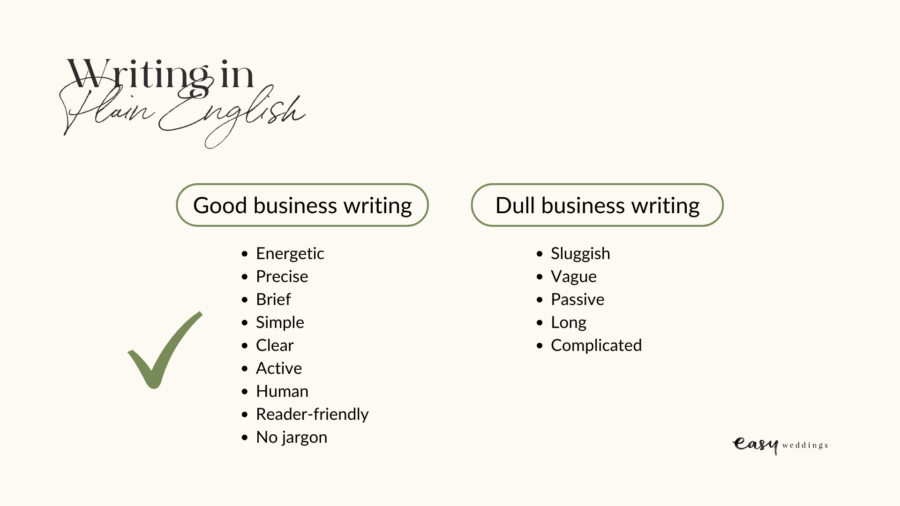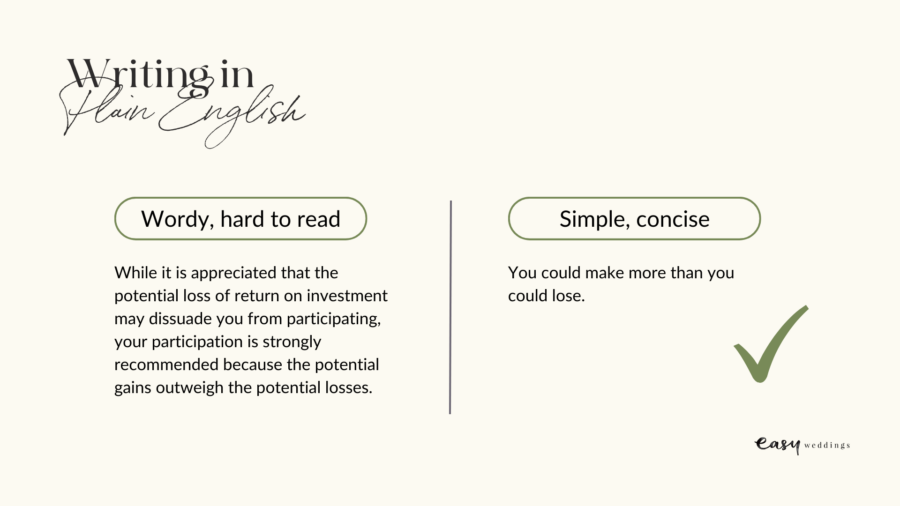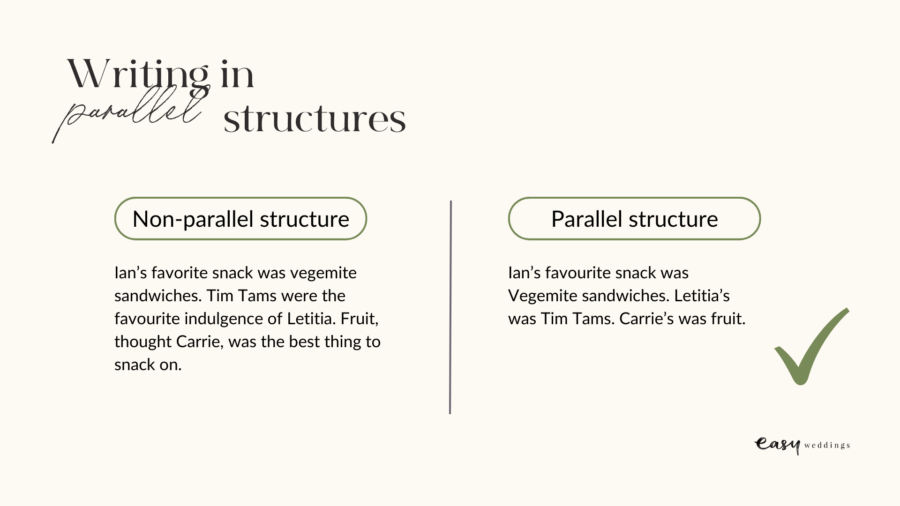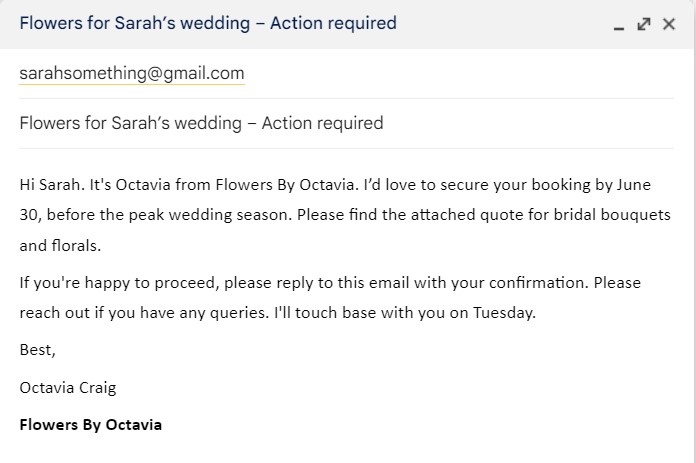Are your emails costing you bookings? Easy Weddings Sales Training Manager Octavia Craig shares her professional business writing tips to help wedding businesses deliver more impactful email communication. Learn how to boost client engagement and close the loop.
As a training lead and former sales manager in the tech industry for 15 years, Octavia has supported sales teams with strategies to achieve excellent results. She’s seen firsthand how simplifying language can save time and boost revenue for small and large-scale businesses.
What is good business writing?
For good business writing, we need energetic, precise, brief, language. We want to use simple, clear, friendly and active language for a human reader, avoiding jargon, Octavia says.
The tone should be more conversational and informal, and we can achieve this by using more personal pronouns, like ‘I’, ‘you’ and ‘we’.
Simplifying language
“What we don’t want is sluggish, vague, passive, long and complicated language”, Octavia suggests. “So use fewer and shorter words to say what you have to say as briefly as possible. Revise and cut the clutter.”
She adds that simplified writing, or “Plain English” is not baby talk, but actually requires considerable skill to master.
When we write something, we want to review it and see what we can cut out.
Limit sentences to one idea and aim for an average of 15 to 20 words per sentence. Reading aloud helps identify where you need a stop for a break and add a full stop. If you’re using a comma, think about whether that could be split into two sentences, too.
“The above examples are essentially the same words, but we’ve shortened the sentence structure,” Octavia says. “We’ve made it one idea per sentence, and we’ve used a more coherent frame.”
6 Steps of Professional Writing
- Preparation
- Research
- Selection
- Planning
- Writing
- Review
1. Preparation
Before you can begin writing, you’ll need to define your audience. Ask yourself: Who is this for? And why is it worth them reading it?
Consider what you really want to tell your reader.
2. Research
Do you need to back up any claims you’re making with data or proof points? If so, how will you demonstrate those?
3. Selection
Next, prepare your Purpose Statement. Ask yourself, what do you want your reader to do, think or feel as a result of reading the document or the email?
You might want them to take your advice; comment on your proposal by Friday; understand why you are not offering a refund; sign and return a contract; buy a product; or fund a proposal in your business case. These are all examples of Purpose Statements.
Your call to action should be clear before you begin writing.
4. Planning
Next, consider how you will organise your ideas or response. What information do you want to share, and where is your information going?
Finally, think about the tone and language most suitable to your reader.
5. Writing
Say it straight, in Plain English. We’re not trying to impress anyone with beautiful writing; we’re trying to articulate clear and simple points.
Parallel Structure to Achieve Paragraph Coherence
Writing your sentences in parallel structures consisting of similar phrases creates a pattern, making it easier for the reader to read, comprehend, and analyse the information. Without a parallel structure, it’s hard for the reader to quickly absorb and make sense of that information.
6. Review
Next, edit and proofread what you’ve written. Reading it aloud can help you determine where you might break up the sentences.
“Whenever you’re writing an email to a client, the last and fairly important step is to go back and proofread it,” Octavia advises.
“The writing process usually begins with preparation, research, selection, planning, and then writing. But the one thing often missed is the final — and arguably most important — step, editing and proofreading.”
Key questions to ask yourself when proofreading:
- What can you cut out? What doesn’t need to be there? That might be ‘How are you today?’
- Where can you take out a comma or full stop?
- How can you shorten a sentence?
- How well are the ideas organised and bound together?
- Do all parts of the paragraph relate to each other?
- Are the sentences logically organised?
- Are the transitions between sentences, smooth?
Top tips for effective email writing
- Use fewer and shorter words. Say what you have to say as briefly as possible.
- Revise and cut the clutter.
- Be polite. Short and sharp writing does not mean rude. You just allow the reader to absorb the information quickly, and that’s what everybody wants. So check that your tone is not abrupt.
- Include a meaningful subject heading, to give it the best chance of being opened. Your email may not be read in full, so your subject is critical. Including their business name grabs their attention, and so does adding ‘Action Required’.
- Instead of a paragraph of text nobody will read, split it into short, sharp sentences.
- Dot points are better than sentences.
- Pictures are better than words.
See the below example of effective email writing:
Final thoughts on business writing that converts
Octavia’s simple steps should guide you to writing more concise and compelling professional emails and documents, to help convert leads. If your writing helps your client understands what you’re asking them to do, it should encourage an action much quicker.
If you aren’t yet online with Easy Weddings and would like to see how we can help increase your brand presence and help book more weddings, submit an online enquiry form, here, and we’ll be in touch.








